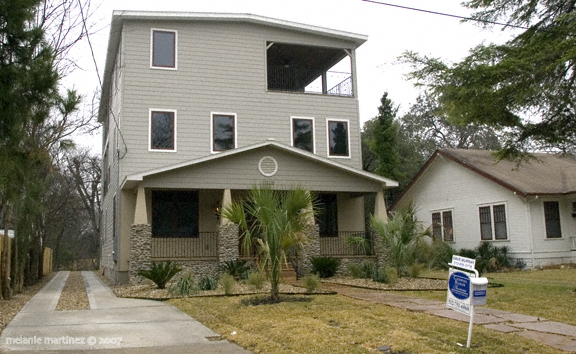Newest CodeNEXT draft gets criticism from all sides
Thursday, February 22, 2018 by
Jack Craver CodeNEXT has plenty of critics, but they’re far from united in their criticism.
The third draft of the proposed Land Development Code is being attacked from both sides of the perennial debate over growth. Neighborhood preservationists say it will lead to the destruction of single-family home neighborhoods and displacement, while urbanists and some housing advocates say the proposal does not do nearly enough to encourage multifamily housing and affordability.
Jeff Jack, president of the Austin Neighborhoods Council, is worried about the reduction of the minimum lot size for single-family homes. Under the proposal, some areas will see the minimum drop from 5,750 square feet to 5,000 square feet and property owners will be able to subdivide the lot into two smaller 2,500-square-foot parcels.
In other areas, the minimum lot size will be 3,500 square feet and will allow two units.
“It will encourage people to buy up our houses and tear them down and turn them into duplexes,” said Jack, who lives in the Zilker neighborhood.
Community Not Commodity, the group pushing to subject CodeNEXT to voter approval, made similar claims in an email. “CodeNEXT does not protect neighborhood integrity, it ignores demolition and displacement of residents,” said Barbara McArthur, one of its activists, in the email.
Jack is also concerned about the decrease in parking requirements. Currently, a residential unit is generally required to have two off-street parking spots. Under the proposal, that would drop to one, and there would be no parking requirement for accessory dwelling units (also known as garage apartments). Minimum requirements for businesses would also drop.
“More street parking means more congestion,” said Jack.
More broadly, Jack and many others in his camp reject the notion that increasing housing supply will necessarily lower the cost of housing. Echoing comments made earlier this year by Council Member Alison Alter, Jack referred to the strategy as “trickle-down.”
In the other camp are urbanists and housing affordability advocates who say that the proposal does very little to undo “exclusionary zoning” and the resulting economic and racial segregation.
Last week, Evolve Austin, the coalition of nonprofits and businesses campaigning for a code that promotes a denser, more connected city, said that the most recent draft does not provide enough opportunities to build “missing middle” housing, such as townhouses or small apartment complexes, and maintains “restrictive development standards” that will inhibit density along the corridors.
On Wednesday, officials from Austin Habitat for Humanity and the Austin Housing Coalition, a group of nonprofit housing developers, held a press conference to advocate for changes in the code that will facilitate more low-cost housing, both through market rate multifamily developments and income-restricted units.
“We can’t support a code that doesn’t meaningfully reduce our affordable housing gap through a better map and a simplified code,” Wayne Gerami, vice president of client services for Austin Habitat, told the Austin Monitor before the conference.
If developers take advantage of the new code’s density bonus program, said Gerami, they will produce a maximum of 6,000 units restricted to those of lower incomes. That will only barely put a dent in the problem, he said, considering that the city’s housing blueprint calls for 60,000 such units over the next decade.
Critics also say the proposed code would fail to provide meaningful relief to middle-income people who do not qualify for subsidized units but are increasingly struggling to find affordable living options in town.
“The two significant tools we have for affordability are density and unit size,” said Frank Harren, a Realtor and longtime urbanist advocate.
In other words, if it costs a developer $500,000 to buy an empty lot in Central Austin, the only way they will recoup their investment and provide some low-cost housing is if they’re allowed to build multiple units on it. If the developer is only allowed to build a single-family home, it’s going to be listed for $1.5 million to $2 million, said Harren.
“If I am able to build five or six units on that lot, then I get to a completely different price point,” he said. “Then I get into the $250,000 to $300,000 price point.”
He points to a 10-unit condo building at 4200 Speedway, in Hyde Park. Those units are appraised at between $150,000 and $170,000. In contrast, the single-family home across the street is worth $1.28 million.
While the proposed code does dramatically increase the number of parcels where homeowners will be able to add a second unit, in the form of an ADU, Harren said that’s not going to bring serious change.
“You’ve got to get to five to six (units),” he said, “for me to call it meaningful change.”
Photo by The Austin Sage made available through a Creative Commons license.
Curious about how we got here? Check out the Austin Monitor’s CodeNEXT Timeline.
The Austin Monitor’s work is made possible by donations from the community. Though our reporting covers donors from time to time, we are careful to keep business and editorial efforts separate while maintaining transparency. A complete list of donors is available here, and our code of ethics is explained here.
You're a community leader
And we’re honored you look to us for serious, in-depth news. You know a strong community needs local and dedicated watchdog reporting. We’re here for you and that won’t change. Now will you take the powerful next step and support our nonprofit news organization?










